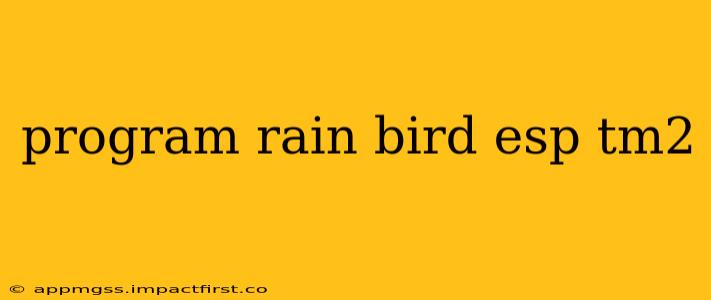The Rain Bird ESP-TM2 is a popular irrigation controller known for its user-friendly interface and robust features. However, programming it correctly is crucial for efficient water usage and a healthy lawn. This guide will walk you through the programming process step-by-step, answering common questions along the way.
Understanding Your Rain Bird ESP-TM2
Before diving into programming, let's familiarize ourselves with the controller's key components. The ESP-TM2 features a clear LCD screen displaying various settings, buttons for navigation, and potentially, additional features depending on your specific model. Take some time to explore the physical buttons and screen displays to understand their functions. Consult your specific model's manual for detailed information on features.
Setting Up Your Irrigation Zones
This is the foundational step. Each zone represents a section of your landscape with a dedicated set of sprinklers. You'll need to define each zone and assign it a unique watering schedule.
How many zones can I program?
The number of zones you can program depends on the specific model of your ESP-TM2. Some models support more zones than others. Check the specifications on your controller's label or in its user manual to determine its capacity.
What if I have more zones than my controller supports?
If you have more zones than your controller supports, you'll need to consider either using multiple controllers or redesigning your irrigation system to consolidate zones. Consult with a professional irrigation installer for advice if necessary.
Programming Your Watering Schedules
This section is where you define how often and for how long each zone waters. Accuracy here is critical for water conservation and plant health.
How do I set the watering time for each zone?
The process will vary slightly depending on your ESP-TM2 model, but generally, you'll use the controller's buttons to select a specific zone and then adjust the watering duration. This is usually expressed in minutes. The manual will provide detailed instructions for your specific model.
What are the best watering times for my lawn?
The optimal watering time depends on your local climate, soil type, and plant species. Generally, early morning (before 10 AM) is preferred to minimize evaporation. Avoid watering during the hottest part of the day to prevent water loss.
How often should I water my lawn?
Watering frequency depends on factors like rainfall, soil type, and plant needs. Overwatering can lead to root rot, while underwatering can stress plants. Monitor your soil moisture regularly and adjust watering schedules accordingly. A soil moisture sensor can be a great addition to your system to automate this adjustment.
Advanced Programming Features
The ESP-TM2 offers advanced features to further optimize your irrigation system.
How do I use the rain sensor with my ESP-TM2?
Many ESP-TM2 models are compatible with rain sensors. These sensors detect rainfall and automatically suspend irrigation when sufficient rain has fallen. The connection process usually involves plugging the sensor into the designated port on the controller. Consult your manual for specific instructions.
Can I program different schedules for different days of the week?
Yes, the ESP-TM2 allows you to create customized watering schedules for each day of the week. This flexibility lets you optimize watering based on predicted weather patterns or specific needs of different plant areas.
How do I program seasonal adjustments?
The ESP-TM2 often includes features to adjust watering schedules based on the season. This allows you to reduce watering during periods of higher rainfall and increase it during drier periods. This is typically achieved through a seasonal adjustment feature within the controller's menu.
Troubleshooting and Maintenance
Regular maintenance is essential for optimal performance.
What should I do if a zone isn't working?
Check for obvious problems such as clogged sprinkler heads, broken pipes, or a malfunctioning valve. Consult your manual for troubleshooting steps specific to the ESP-TM2.
How often should I check my controller?
Regularly inspecting your controller (at least monthly) can help you identify potential issues early on. Check for any error messages, unusual behavior, and ensure all connections are secure.
By following these steps and referring to your specific ESP-TM2 manual, you can effectively program your irrigation system and enjoy a healthy, thriving landscape. Remember that understanding your specific needs and local climate conditions will help you fine-tune your watering schedules for optimal water efficiency.
